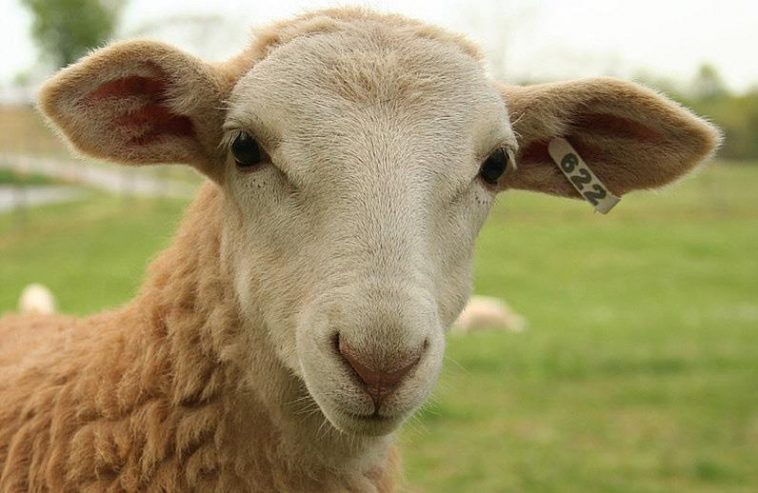One of the most important aspects of any animal-based agricultural operation is having an effective waste management plan which reaps the benefits of the waste and helps reduce the risks associated with the use and disposal of animal wastes.
Improper manure management can have a detrimental effect on water quality. Monitoring animals on a regular basis is not the most popular task on the farm. Waste can therefore easily accrue to unmanageable levels before anyone notices. This month we look at different methods to handle sheep waste.
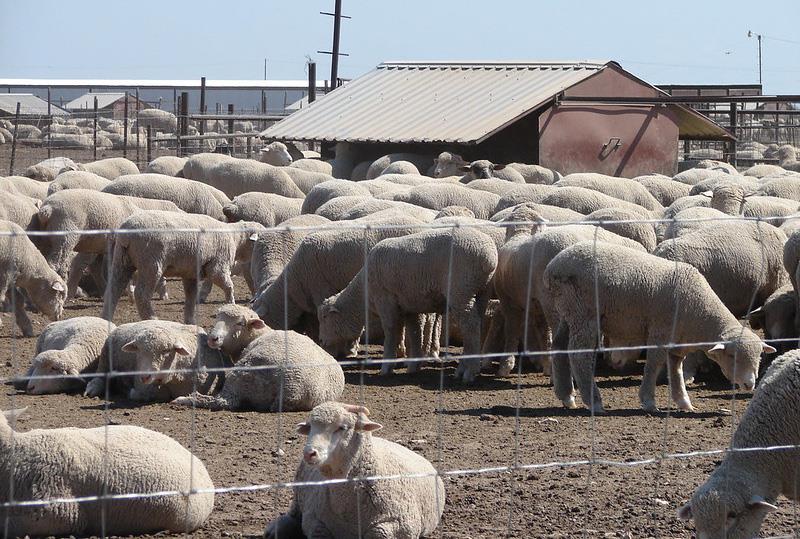
Sheep in a feedlot system. (Image source: flickr.com)
Systems and methods
The handling of waste has come to the fore strongly the past few years resulting from the pollution potential of waste. The direct inlet of run-off water from feedlots and intensive production systems into rivers and streams is currently prohibited by legislation and it is the responsibility of the designer of these systems to ensure that waste is handled according to the prescribed norms and standards. As production systems are intensified, stricter legislation is expected.
The correct handling of waste will not only decrease potential pollution, but also diseases and unpleasant odours. Waste handling in systems with a large component of planted crops or natural grazing, is normally not a problem, because it is already spread over a wide area. A directive to be considered here to minimise diseases and pollution, is that no waste handling measures are necessary if the area utilised as grazing is large enough to maintain vegetation. In intensive systems, waste is handled according to the layout of the facility.
In open feedlots, liquids are collected by means of a run-off control system after which the solids are separated from the liquids in a sedimentation dam. Quantities to be removed vary from 60% of this average figure, depending on the ration, number of sheep per square metre, and the feedlot surface. The tempo of manure removal from a feedlot is determined partly by climate conditions, animal comfort, available labour, as well as water and air pollution. Sedimentation dams are usually shallow structures lined with concrete to simplify the maintenance and cleaning process. The inlet to the sedimentation dam is bevelled to a fall of ± 10% to make access for a tractor possible.
The filter can be made of ordinary rectangular bales that hold back the solids and let the water seep through. As the effectiveness decreases, the bales are removed and replaced by new ones. The filter can also be a stone stratum consisting of a mass of small round stones that retains the solids and lets the water flow through. The stones must be sprayed clean regularly to prevent blockage.
The liquid flows from the sedimentation dam to a storage dam where it either evaporates or is pumped out by an irrigation system or other distribution method onto nearby fields. Alternatively, the liquid can be led away to an infiltration dam or a vegetated area to evaporate or infiltrate there. The solids are immediately spread onto the nearby fields or stored in heaps for composting or later distribution. Maize cobs covered with a layer of straw can be used as a basis for the dung heap.
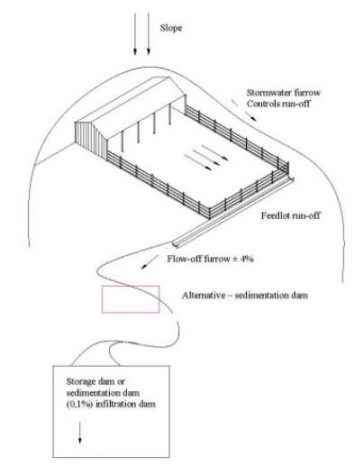
This sketch illustrates how sheep waste can be handled in an open feedlot system. In open feedlots, liquids are collected by means of a run-off control system, after which the solids are separated from the liquids in a sedimentation dam. (Source: Sheep Facilities Manual, ARC-Agricultural Engineering)
Directives for waste handling systems:
- The infiltration dam in which the water is accumulated must be at least 100 m long and preferably have a slope of about 0,25%. The infiltration tempo of the region will decrease drastically with time and can cause problems if sedimentation dams are not used to remove solids beforehand.
- The use of infiltration dams are only recommended for production systems with fewer than 750 animals. Alternatively, water must flow into storage dams and be sprayed out onto fields.
- The slope of the first 20 m of the run-off control system must be approximately 4% to achieve run-off from the housing complex as soon as possible and to prevent deposit of solids in the canals. The slope can then be graded to approximately 1% to the sedimentation dam.
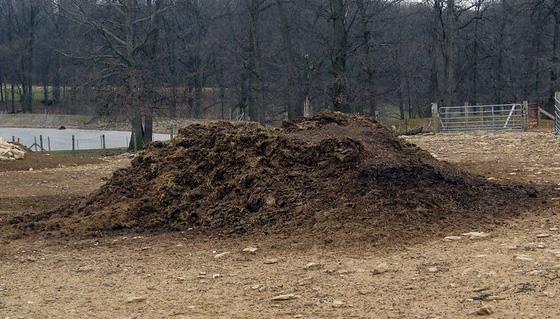
Manure pile. (Image source: flickr.com)
The size of the sedimentation dam can be calculated from:
- surface approximately 1/40 of the total feedlot area.
- volume 0,15 – 0,3 m3 for each 10 m2 of the feedlot surface (These values can be smaller in regions with a low to very low rainfall).
Manure storage
Storage of livestock wastes and wastewater involves accumulating manure in an environmentally sound manner until it can be applied to land or otherwise utilised. Manure storage facilities allow farmers to spread manure when the conditions are right for nutrient use by crops.
Applying manure
Animal waste is rich in plant nutrients and can be used successfully as fertiliser. Approximately 50 to 70% of the total nitrogen intake and 60 to 80% of the phosphorous intake of animals are excreted in the waste.
The nitrogen occurring in the animal waste, however, varies in plant availability and occurs in a number of chemical compositions of which ammonia (NH3) constitutes about 60%. The plant’s available nitrogen is approximately 30 to 70% of the total nitrogen present in animal waste. The relatively low values occur in solids, while higher values refer to the plant available nitrogen in the liquid portion of the excretions.
Land application is the most effective and economical way to utilise solid manure, as long as the manure is not applied to sloping ground, frozen land, or on slopes near ditches, streams, and roads. To get the most value from your manure, you should apply it close to planting time. Applying manure at this time makes it less likely you will lose nutrients to leaching or runoff. Application should preferably be done subsurface (plough directly after application).
Manure as a fertiliser
Manure contains valuable nutrients such as nitrogen (N), phosphorus (P), and potassium (K). In addition to the three major elements, manure also contains essential micro-nutrients including boron, calcium, copper, iron, magnesium, manganese, molybdenum, sulphur, and zinc. Manure nutrients come from the feed that the animals have eaten.
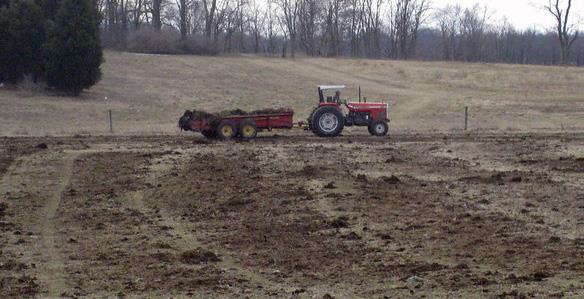
Spreading manure. (Image source: flickr.com)
Other benefits of the use of animal waste as fertiliser include:
- The favourable influence on trace elements in the soil.
- The improvement of the ion exchange ability of the soil.
- The improvement of the soil structure which determines, among others, infiltration, water retention ability and arability.
Methods of controlling and eliminating unpleasant odours include the following:
- Correct zoning with regard to farmhouses, other housing and wind directions will decrease the detection of odours.
- Biochemical additives to limit the production of gases.
- Air fresheners to limit the detection of odours.
- Correct storage of waste matter.
- Effective manure dams.
- Tillage of fields directly after spreading.
- Regular removal of manure.
- Air-drying of solid waste.
We thank the ARC Institute for Agricultural Engineering in South Africa who made their manual on sheep production and facilities available to the readers of ProAgri.

